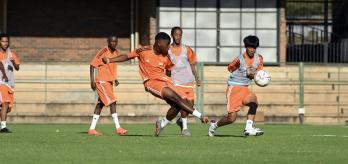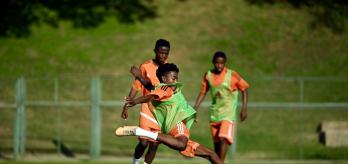Methodology
The intention: What is practised?
This opposed drill offers players the opportunity to work on finishing scenarios from either side of the goal and aims to enhance a player’s ability to create and finish goalscoring chances. The objective of the exercise is to improve a player’s accuracy in front of goal when under pressure. The exercise focuses on player actions and skills, such as the timing and coordination of movement in attack to ensure that they are in the right position to take on the defender after receiving the ball. Players are asked to move onto the pass to gain momentum and an advantage over the defender. The attacker should try to overcome the defender and work the space for a shot by performing feints.
The scale: For whom is this relevant?
This finishing exercise revolves around the player scale, homing in on players’ ability to create shooting opportunities in 1v1 scenarios. The drill is particularly relevant to forwards who are tasked with creating shooting chances for themselves in the final third. The sequence simulates a pass played into a forward who is positioned on the edge of the area and pulls away from the inside channel to move centrally towards goal and is confronted by a pressing defender. The exercise is relevant to forwards and allows them to work on on-the-move actions, such as driving at defenders or receiving the ball when attacking the goal.
The practice type: How is the practice designed?
The drill involves finishing actions that are designed to improve a player’s ability to receive the ball on the move and direct it towards goal before shooting. The starting positions occupied by the forward and the passer are designed to increase the forward’s efficiency in terms of positioning themselves to take on a defender with a view to getting into a goalscoring position when receiving the ball on the run. The defender applies the necessary pressure to allow attackers to sharpen and improve their execution in a game-like scenario. The combination of the defender’s pressure, the attacker’s movement and the pass ensure that static situations, which are contrary to the objectives of the exercise, are avoided.
Session plan
Organisation
-
Mark out a 30m x 30m exercise area.
-
Position a full-size goal at 1 end of the exercise area.
-
Place a goalkeeper in the goal.
-
Split the group into 2 teams of 5 (oranges and blues).
-
Position a cone a few metres inside the penalty area and on either side of the goalposts.
-
Place 3 blue players at the right-hand cone and 3 orange players at the left-hand cone.
-
Lay a second pair of cones (marked 1 and 2 in the graphic above) just beyond the playing area, towards the halfway line, and in line with the points where the penalty arc intersects with the penalty area.
-
Place 2 blue players at cone 1 and 2 orange players at cone 2.
Explanation
-
The exercise starts with the players positioned at the cones marked 1 and 2 in possession.
-
The first orange player at cone 2 plays a diagonal pass to the first orange player at the left-hand cone nearest to the goal, who drops to receive the ball before shooting on goal unopposed.
-
The orange player who shot on goal takes up a position on the edge of the penalty area in readiness to defend against the blue player at the right-hand cone nearest to the goal, who receives a diagonal pass played by the blue player at cone 1 and tries to beat the orange defender before shooting on goal.
-
The sequence continues in this way with opposed scenarios, with the players at cones 1 and 2 taking it in turns to play the ball into their team-mates.
Key coaching points
Roles of the coach
• First coach: leads the exercise and coaches the players to perform the required actions.





















































